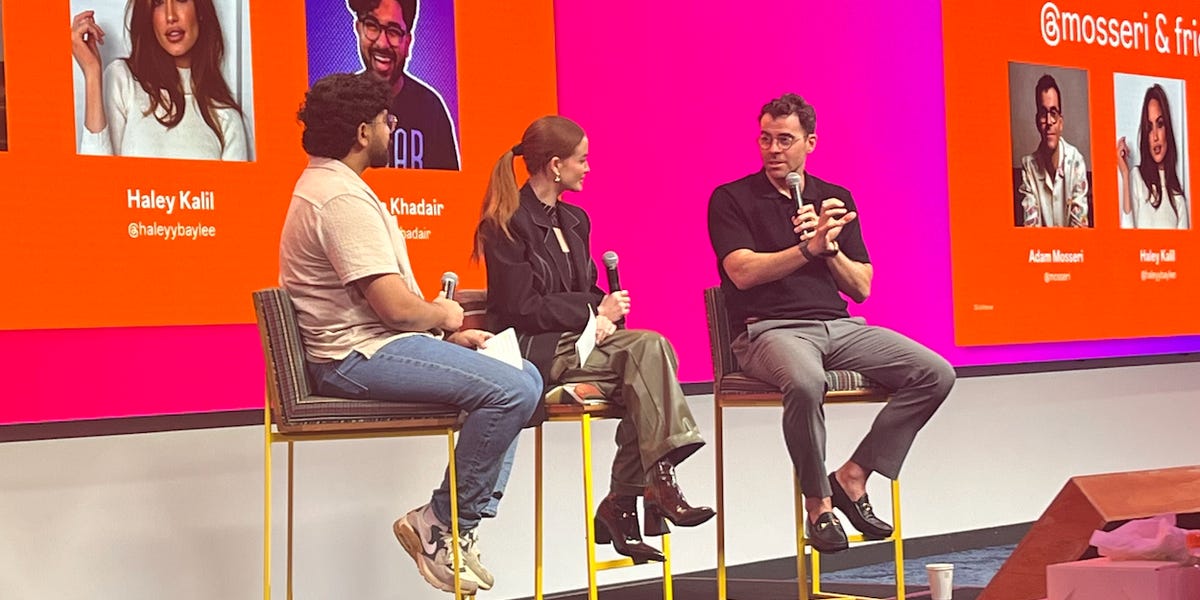Adam Mosseri, head of Instagram, doesn’t “like to talk shit about competitors” … but he has some thoughts.
At an event held at Meta’s New York headquarters on Thursday, Mosseri sat down with two creators — Haley Kalil and Hassan Khadair — for a fireside chat about Instagram’s creator initiatives and how they compare to competitors like TikTok, Snapchat, and YouTube.
Unsurprisingly, money was a big topic of conversation.
Kalil, a content creator with over 5.8 million followers on Instagram, explained to Mosseri that she’s been making money across competitors like YouTube, TikTok, and Snapchat. (Kalil also earns on Meta’s platforms, she said during the event.)
Mosseri wasn’t shy about critiquing Instagram’s competitors when it came to how they pay creators.
“There’s no way that Snap program is sustainable,” he said, likely referring to its ad-revenue share program for its Stories feature that has earned some creators more than a million dollars.
“If you are on that program and you get your purse, great, that is awesome,” Mosseri said. “But if I’m just your friend, I’m not going to recommend that you bank on that being around forever.”
Creators know all too well that platform payment programs can be fleeting or underwhelming.
TikTok previously launched a creator fund and ad-revenue share program, both of which often paid out meager sums that amounted to pocket change for creators rather than sustainable income. The company’s newer creator rewards program has been far more lucrative, however.
Snapchat previously released its own creator fund for short videos on its Spotlight feed, but repeatedly lowered its total payouts for the program.
Mosseri acknowledged that it was important for platforms to be honest about how long a program may stick around.
Last month, the company rolled out a new temporary “Spring Bonus,” which he said was called Spring Bonus and not the “permanent bonus program” because he wanted to set expectations.
“If I said we’re going to pay all creators forever, you guys would all cheer, but I would be over-promising,” he said.
Khadair (who has over 400,000 followers on Instagram) asked Mosseri a very fair question: Why does Kalil have access to the program, but not him?
“We’re experimenting,” was Mosseri’s shorter answer. The longer answer was that Instagram is running the test with different groups of creators to see how it could scale the program so that it isn’t another temporary fix.
“It just has to be a sustainable business,” Mosseri said. “We’re not going to run if the spring bonus program loses money.”
Meta previously scaled back on its test of a bonus program, which paid out creators based on the performance of their reels between 2021 and 2023.
For Instagram’s bonus program to be successful, it would need to meet three criteria, according to Mosseri:
- It’s a sustainable model, and Meta is not “burning cash.”
- Creators are earning enough money that the “checks aren’t embarrassing,” such as $12 per month. “That’s not really great for anybody, either.”
- Eligibility for the program is public and standardized. Currently, that criteria is being tested and iterated on across different markets, Mosseri added.
“We’re going to continue to iterate,” Mosseri said. “But it’s not going to be permanent, and it’s not going to be at what I think of as real scale until we meet those three criteria.”
While Mosseri jabbed at Snap’s creator monetization program during his presentation, he also praised YouTube’s monetization features for creators, adding that its Partner Program is “by far the most advanced” and the only app in the ecosystem that “pays consistently.”
YouTube has also recently been testing short-video payouts, though its shorts fund and ad-revenue share initiative have received mixed reviews from creators.
It’s harder for platforms to attribute an ad to an individual’s video in short-video feeds compared to long-form, where pre-roll, mid-roll, and post-roll ads can be tied back to a particular creator’s content. But as short video gobbles up attention time across platforms, it’s a challenge that platforms need to solve.
‘The thing I’m most excited about is subscriptions’
The bonus program wasn’t the only feature top of mind for Mosseri.
“The thing I’m most excited about is subscriptions,” Mosseri said. “But subscriptions are only relevant to maybe one in 20 creators.”
Mosseri hailed the subscriptions feature as a much more “predictable” income creators can rely on than ad revenue or brand deals. And while it isn’t useful for every creator, Instagram recently announced that there are now 2 million active subscriptions to creators on the app.
Mosseri also took a moment at the event to explain how Instagram would double down on original content across the app as a way to help smaller creators receive credit and engagement for their content.
“We’re moving in the next month or two to try to stop recommending content from aggregators as a way to favor our original creators,” he said.
Read the full article here





